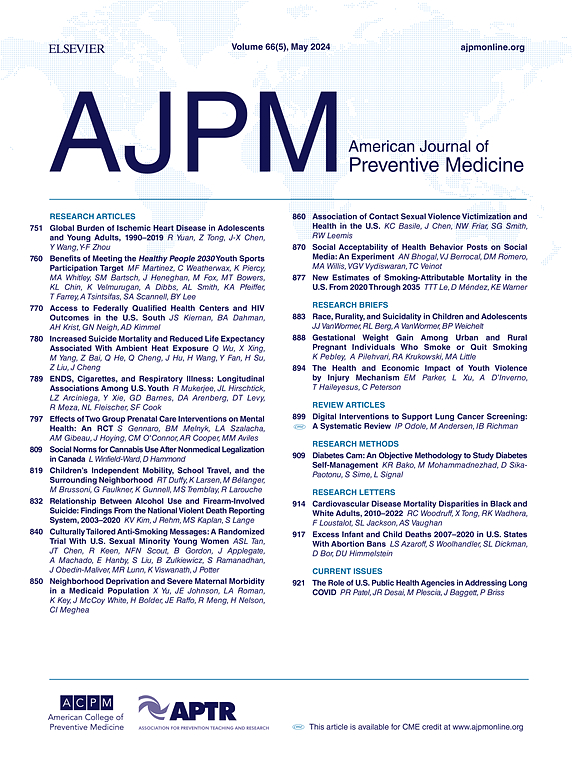各州非医用大麻法律和美国年轻人的大麻相关经历。
IF 4.3
2区 医学
Q1 MEDICINE, GENERAL & INTERNAL
引用次数: 0
摘要
引言:本研究调查了大麻零售法律与年轻人的相关经历(例如,广告曝光)之间的关系,年轻人的使用率最高。方法:研究了三类与非医用大麻零售相关的法律:1)经营限制(例如,营业时间、分区限制),2)广告限制(通过媒体渠道、健康声明、赠送/折扣),以及3)要求的警告(在广告中,在零售商处)。因变量来自对19个非医用大麻零售州(2023年6月至11月)的美国年轻人的调查,包括:大麻零售商访问的频率、广告曝光、使用后驾驶,以及(对于过去一年访问零售商和过去一个月使用的人)注意到最低年龄标志、健康声明、赠品和零售商的折扣。多变量分析检查了与相关结果相关的零售相关法律。结果:在所有参与者(n=1,847)中,发现了以下关系:零售许可证限制与零售商访问量减少;限制广告牌广告,减少广告牌广告曝光;并要求在广告中出现与驾驶有关的警告,减少使用后开车的可能性。在访问零售商的人中(n=843),存在以下联系:面向青少年的设施(但不包括学校)的分区限制与注意到最低年龄标志;限制产品上的健康声明,降低健康声明的曝光率;限制赠送,少注意赠送;限制折扣,更多的是注意折扣。没有其他重大关联(例如,限制在线广告和曝光,需要带有风险认知的警告)。结论:某些规律与年轻人的预期体验有关;然而,其他法律与结果没有关联。需要进行评估人口影响和行业合规的持续研究,以便为法规和实施提供信息。本文章由计算机程序翻译,如有差异,请以英文原文为准。
State Nonmedical Cannabis Laws and U.S. Young Adults’ Cannabis-Related Experiences
Introduction
This study investigated the associations between cannabis retail laws and relevant experiences (e.g., advertising exposure) among young adults, who have the highest use prevalence.
Methods
Three categories of nonmedical cannabis retail-related laws were examined: (1) operational restrictions (e.g., operating hours, zoning restrictions), (2) advertising restrictions (by media channels, health claims, giveaways/discounts), and (3) required warnings (in ads, at retailers). Dependent variables were from surveys of U.S. young adults in 19 states with nonmedical cannabis retail (June–November 2023), including frequency of cannabis retailer visits, advertising exposure; driving after use; and (for those with past-year retailer visits and past-month use) noticing minimum-age signage, health claims, giveaways, and discounts at retailers. Multivariable analyses examined retail-related laws in relation to relevant outcomes.
Results
Among all participants (N=1,847), associations were found between retail license limits and fewer retailer visits, restricting billboard ads and less billboard ad exposure, and requiring driving-related warnings in ads and less likely driving after use. Among those who visited retailers (n=843), there were associations between zoning restrictions for youth-oriented facilities (but not schools) and noticing minimum-age signage, restricting health claims on products and lower health claim exposure, restricting giveaways and less often noticing giveaways, and restricting discounts and more often noticing discounts. There were no other significant associations (e.g., restricting online advertising and exposure, required warnings with risk perceptions).
Conclusions
Certain laws were associated with anticipated experiences among young adults; however, other laws showed no association with outcomes. Ongoing research assessing population impact and industry compliance is needed to inform regulations and implementation.
求助全文
通过发布文献求助,成功后即可免费获取论文全文。
去求助
来源期刊

American Journal of Preventive Medicine
医学-公共卫生、环境卫生与职业卫生
CiteScore
8.60
自引率
1.80%
发文量
395
审稿时长
32 days
期刊介绍:
The American Journal of Preventive Medicine is the official journal of the American College of Preventive Medicine and the Association for Prevention Teaching and Research. It publishes articles in the areas of prevention research, teaching, practice and policy. Original research is published on interventions aimed at the prevention of chronic and acute disease and the promotion of individual and community health.
Of particular emphasis are papers that address the primary and secondary prevention of important clinical, behavioral and public health issues such as injury and violence, infectious disease, women''s health, smoking, sedentary behaviors and physical activity, nutrition, diabetes, obesity, and substance use disorders. Papers also address educational initiatives aimed at improving the ability of health professionals to provide effective clinical prevention and public health services. Papers on health services research pertinent to prevention and public health are also published. The journal also publishes official policy statements from the two co-sponsoring organizations, review articles, media reviews, and editorials. Finally, the journal periodically publishes supplements and special theme issues devoted to areas of current interest to the prevention community.
 求助内容:
求助内容: 应助结果提醒方式:
应助结果提醒方式:


